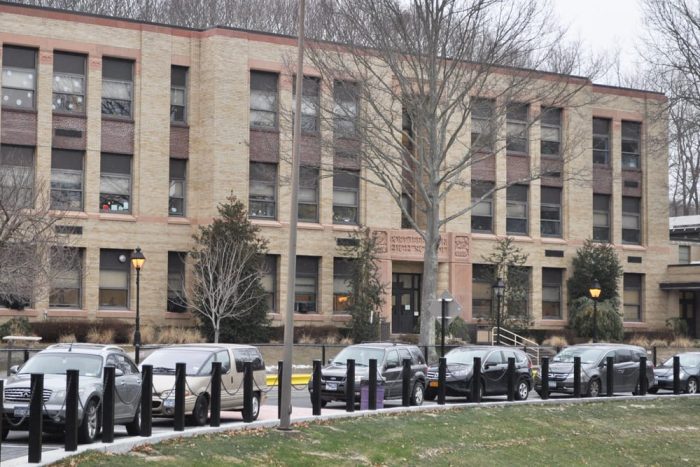By Lynn Hallarman
A lawsuit upheld in 2022 a local business owner’s right to display a political banner, and now raises questions about municipal control over sign safety and aesthetics. The same sign, “In Trump We Trust,” is back up again.
In 2013, then Port Jefferson Village Mayor Margot Garant knew she had a problem — a proliferation of cheaply made signs cluttering the village’s visual look. Some signs were made of flimsy plastic, pressboard or haphazardly tacked up to storefronts. Some were waving in the breeze, at risk of flying off a facade or airlifting skyward off a property lawn. Others were just unsightly.
Garant and the trustees decided to revise the village code to help business owners have more choices as a first step to cleaning up junky and unsafe signs.
‘We had many work sessions to improve the code and make businesses feel like they had options,” Garant said. “Uptown was a sign disaster, but we made progress cleaning up storefronts in line with the village’s character overall.”
Garant found the sign issue perennial and hard to keep up with. New businesses were easier to manage, but for some older establishments compliance with sign rules felt like government overreach. A few businesses ignored the permitting process altogether or accepted a fine as the price of doing business, according to Garant.
Then, in 2020, George Wallis, from Nissequogue, and the decades-long owner of the property housing the Frigate ice cream/confectionary store and The Steam Room restaurant in the village, used the location to express his support for former President Donald Trump (R).
Wallis hung an oversized banner containing a political statement off the second-story balcony of the Frigate, a prominent spot at the bustling intersection of East Broadway and Main Street. The building is directly across from the Bridgeport & Port Jefferson Ferry terminal, making the display hard to miss.
From the perspective of village officials, the banner violated several village sign requirements and Wallis did not apply for a permit.
For one thing, the banner has Goliath-size proportions relative to the dimensions of the two-story Lilliputian-style building. Banners affixed to buildings are not allowed per the code and the pliable plastic material used does not comport with the aesthetic standards of the code. Village officials also worried that the oversized banner, strung across the building’s second-floor balcony, was a driving distraction, as it faces west directly into a three-way intersection — with pedestrians, oftentimes, dashing across the road. Officials wanted it taken down.
Wallis had wrestled previously with the village government over an unpermitted political sign and had it taken down, but this time he refused to budge.
So the village escalated the situation to a legal remedy in the courts in hopes that he would back down, according to Garant. Wallis, instead, hired a lawyer and fought the charges leveraged against his business entities.
But in several interviews for this story with Garant and current Mayor Lauren Sheprow, opinions from municipal legal experts and a review of publicly available documents suggest that the legal battle, which Wallis won using a free-speech argument, has hamstrung the village’s ability to enforce its sign code and established a legal precedent allowing any person or business to erect a prohibited sign if the content is political.
The legal complaint
A series of legal briefs filed in 2020 and 2021 by then deputy village attorney Richard Harris, for the Village of Port Jefferson, accused several business entities owned by Wallis of violating local sign ordinances. According to documents reviewed by TBR News Media, these entities allegedly failed to apply for permits and displayed signs of prohibited type, size and material.
The briefs detail the hanging of two signs in different time frames containing political speech: “In Trump We Trust” and “Impeach Cuomo,” referring to the then New York governor. The charges did not pertain to the banners’ political content, which is protected under the First Amendment’s right to free speech.
Still, Wallis’ attorneys claimed the alleged accusations violated his right to free speech and requested dismissal of the case.
Harris argued, in a nutshell, that Wallis needed to follow the village sign code like everyone else.
In July 2022, the Honorable Tara Higgins, judge of the village Justice Court, ruled in favor of Wallis, stating that the village’s arguments defending sign ordinances regarding aesthetics, safety and permitting were “unconvincing.”
Village withdraws legal appeal
Harris submitted a legal appeal, reviewed by TBR News Media, to the Appellate Term of the New York Supreme Court arguing that the judge’s arguments were poorly reasoned and ignored legal precedent regarding a municipality’s ability to govern signs.
According to the New York State Division of Local Government Services, local governments may impose reasonable “time, place and manner” restrictions on speech to set forth the circumstances under which signs may be displayed. Obscene content is not allowed.
“All I can say is that based on the United States Supreme Court precedent, the village can enforce its code against the sign like that,” Mark Cuthbertson, lawyer and municipal legal expert, told TBR in a phone interview.
He added, “If that’s the village’s policy going forward, based on this legal decision, someone can put up a huge Kamala Harris banner wherever [and however] they want.” He noted that other municipalities may face similar challenges to their sign code rules based on this new legal precedent, which seems to allow political signs to bypass municipal sign ordinances.
The Sheprow administration subsequently withdrew the village appeal, stating that it “wanted a fresh start” and planned to take “steps against any sign code violations” regardless of the sign’s content.
Reactions from the public
TBR spoke with several patrons on the weekend of July 20-21 near the Frigate to gauge their opinions on the newly-placed banner with the same political message that was displayed in 2020.
Most expressed approval using descriptors such as “delighted,” “ecstatic” and “in favor.” One woman thanked me for reminding her to take a picture of the banner for her Facebook page. She loved the sign.
The general sentiment among those surveyed was that the banner represented an expression of free speech and that the village needed to “chill out,” as one supporter put it. Others noted that the village seemed to be enforcing its sign code selectively, singling out the Frigate for sanctions while similar style banners are hung undisturbed throughout downtown Port Jeff. In 2020 press reports, Wallis surrogates had voiced this belief of selective enforcement, suggesting that the village’s actions were driven solely by the banner’s political message.
Wallis has consistently declined to speak with the press. TBR did not receive a response, either, from the Frigate’s store manager for comment.
During a casual stroll around the village, this reporter identified about seven prohibited banners across various businesses, though these banners contained nonpolitical messages.
Most of the complaints about the current Frigate banner are directed to the village Town Hall or The Greater Port Jefferson Chamber of Commerce, according to Sheprow. These complaints primarily concern the political content, accusing the village of allowing it to remain. However, the village never had or wanted control over the political content, even before Wallis’ victory in court.
“The village is nonpartisan,” Sheprow said. “The village would never enter into an endorsement situation or sanction the political speech of any candidate.”
As of writing, village officials have moved to cite all businesses, many for the first time, which are displaying code-prohibited banner-type signs.
“Personal notifications went out today, including to Mr. Wallis’ business entities,” Sheprow said.
Many prohibited banners have already been removed to date. As at press time, the Frigate banner was still hanging from the building.




















